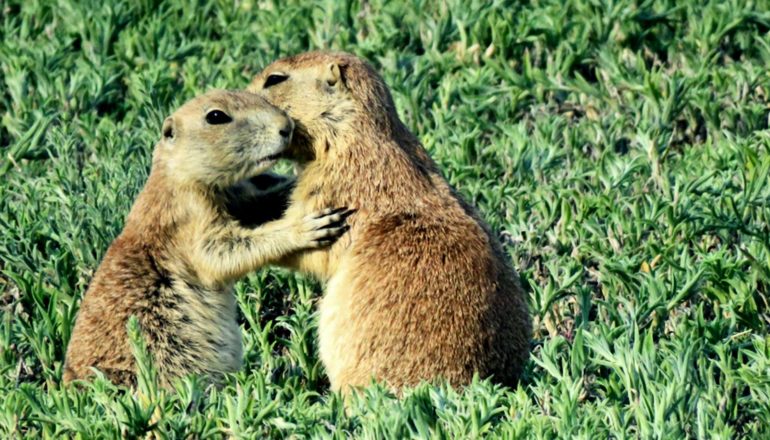
Prairie dogs—those chubby little burrowing rodents found in grasslands across the central and western United States—have intricate social networks, a new study shows.
Understanding their connections, interactions, and surprisingly complex world could help wildlife conservationists more successfully relocate and reintroduce species into the wild.
Jennifer Verdolin, an assistant professor of conservation biology in the School of Natural Resources and the Environment at the University of Arizona, has studied prairie dogs for nearly two decades.
“They’re such underdogs. Everything eats them, but they’re so tough and observant,” says Verdolin.
“People look at them like they’re just this big rat, but they have unique language; they have dialects. They collaborate and have cultural differences between colonies.”
‘Everybody is kissing everybody’
Huddled in the prairies surrounding Flagstaff, Arizona, Verdolin has watched prairie dog colonies outwit predators, learned their intricate speech patterns, and observed thousands of “greet kisses”—that’s right, prairie dogs are big on smooching.
“They greet each other with a kiss, and individuals that kiss each other and don’t fight afterwards belong to the same social group and territory,” Verdolin says. “All you need to do is watch. The more times they’ve kissed, the stronger the connection.”
Much like grooming behavior in primates, prairie dog “greet kisses” reveal complex social networking. Verdolin observed 80 prairie dogs, spanning 14 social networks. Unlike other animals, prairie dogs don’t have a hierarchical social structure. In other words, there’s no top (prairie) dog.
“This actually goes counter to most prairie dog literature, that says there’s a single male and a harem of females. That’s simply not what we’re seeing,” Verdolin says. “Most social groups are made up of multiple males and multiple females. Everybody is kissing everybody, and the babies are the result of all that activity.”
But, according to Verdolin, not everyone gets kissed equally. There are community bridges—those that kiss members of neighboring social groups, and there are hubs—those that just seem to get all the kisses.
All those prairie dog kisses helped Verdolin map the intricacies of their social dynamics—from how many friends a particular prairie dog had, known as “degree centrality” in social network analysis language, to how many connections an individual prairie dog facilitated, otherwise known as “between-ness centrality.”
Prairie dog relocation
Social networking analyses like this one have been used in ecological studies for a little over a decade and help ecologists understand how and when a species leans on its community. Predators, environmental conditions, and food availability all contribute to the ebb and flow of social interactions.
Recently, there have been a number of studies across wildlife species investigating how resource availability shapes social group dynamics. Killer whales, for example, become more clustered and connected when salmon are more abundant. A similar pattern has been observed in giraffes, with whole networks coming together during the wet season—again a time when food is more readily available.
Where resources affect social behavior, most wildlife systems are believed to be fission-fusion, meaning a group might split up to forage when resources are lean and then come back together when they are abundant, Verdolin explains. Gunnison’s prairie dogs—the species Verdolin focused on for this study, published in the journal Behaviour, are a little different.
“Here, we basically have a species that maintains a territory year-round, maintains a social group year-round, and the amount of food that’s available will change the way they interact with each other, the strength of those interactions, and the frequency of those interactions,” Verdolin says.
The fine intricacies of those social engagements have big implications for conservation efforts. While having enough resources to support a colony is important, it’s not the only factor that underpins survival. How the animals interact, particularly in high-stress situations, changes everything from how disease moves through a population to how information is transferred, or cultural learning might happen in a social group.
“This is huge because behavior isn’t typically integrated into prairie dog conservation management, restoration, and relocations,” Verdolin says. “If you’re going to reintroduce or relocate them from one place to another, you can’t just scoop them up and plop them on a landscape because you’ve decided it’s suitable.”
Often, prairie dog relocations occur when colonies stand in the way of new construction or when they are considered to be destructive to a landscape, such as a golf course. The success of most relocation efforts is very low, which has cascading consequences for the more than 100 species that benefit from the presence of prairie dogs, Verdolin says.
“With certain species, like prairie dogs, it’s important to consider all of the factors that support their survival—not just food abundance, but also the size of the group, the spatial orientation of its members, and how that influences social interactions,” Verdolin says. “And it’s important to try to match those elements as much as possible when doing relocations of social groups or of social species.”
Source: University of Arizona
The post Social prairie dogs ‘greet kiss’ to connect appeared first on Futurity.
from Futurity https://ift.tt/3lP1M8n
No comments:
Post a Comment